Junda Wu
WildScore: Benchmarking MLLMs in-the-Wild Symbolic Music Reasoning
Sep 05, 2025Abstract:Recent advances in Multimodal Large Language Models (MLLMs) have demonstrated impressive capabilities across various vision-language tasks. However, their reasoning abilities in the multimodal symbolic music domain remain largely unexplored. We introduce WildScore, the first in-the-wild multimodal symbolic music reasoning and analysis benchmark, designed to evaluate MLLMs' capacity to interpret real-world music scores and answer complex musicological queries. Each instance in WildScore is sourced from genuine musical compositions and accompanied by authentic user-generated questions and discussions, capturing the intricacies of practical music analysis. To facilitate systematic evaluation, we propose a systematic taxonomy, comprising both high-level and fine-grained musicological ontologies. Furthermore, we frame complex music reasoning as multiple-choice question answering, enabling controlled and scalable assessment of MLLMs' symbolic music understanding. Empirical benchmarking of state-of-the-art MLLMs on WildScore reveals intriguing patterns in their visual-symbolic reasoning, uncovering both promising directions and persistent challenges for MLLMs in symbolic music reasoning and analysis. We release the dataset and code.
SAND: Boosting LLM Agents with Self-Taught Action Deliberation
Jul 10, 2025Abstract:Large Language Model (LLM) agents are commonly tuned with supervised finetuning on ReAct-style expert trajectories or preference optimization over pairwise rollouts. Most of these methods focus on imitating specific expert behaviors or promoting chosen reasoning thoughts and actions over rejected ones. However, without reasoning and comparing over alternatives actions, LLM agents finetuned with these methods may over-commit towards seemingly plausible but suboptimal actions due to limited action space exploration. To address this, in this paper we propose Self-taught ActioN Deliberation (SAND) framework, enabling LLM agents to explicitly deliberate over candidate actions before committing to one. To tackle the challenges of when and what to deliberate given large action space and step-level action evaluation, we incorporate self-consistency action sampling and execution-guided action critique to help synthesize step-wise action deliberation thoughts using the base model of the LLM agent. In an iterative manner, the deliberation trajectories are then used to finetune the LLM agent itself. Evaluating on two representative interactive agent tasks, SAND achieves an average 20% improvement over initial supervised finetuning and also outperforms state-of-the-art agent tuning approaches.
A Personalized Conversational Benchmark: Towards Simulating Personalized Conversations
May 20, 2025Abstract:We present PersonaConvBench, a large-scale benchmark for evaluating personalized reasoning and generation in multi-turn conversations with large language models (LLMs). Unlike existing work that focuses on either personalization or conversational structure in isolation, PersonaConvBench integrates both, offering three core tasks: sentence classification, impact regression, and user-centric text generation across ten diverse Reddit-based domains. This design enables systematic analysis of how personalized conversational context shapes LLM outputs in realistic multi-user scenarios. We benchmark several commercial and open-source LLMs under a unified prompting setup and observe that incorporating personalized history yields substantial performance improvements, including a 198 percent relative gain over the best non-conversational baseline in sentiment classification. By releasing PersonaConvBench with evaluations and code, we aim to support research on LLMs that adapt to individual styles, track long-term context, and produce contextually rich, engaging responses.
CachePrune: Neural-Based Attribution Defense Against Indirect Prompt Injection Attacks
Apr 29, 2025Abstract:Large Language Models (LLMs) are identified as being susceptible to indirect prompt injection attack, where the model undesirably deviates from user-provided instructions by executing tasks injected in the prompt context. This vulnerability stems from LLMs' inability to distinguish between data and instructions within a prompt. In this paper, we propose CachePrune that defends against this attack by identifying and pruning task-triggering neurons from the KV cache of the input prompt context. By pruning such neurons, we encourage the LLM to treat the text spans of input prompt context as only pure data, instead of any indicator of instruction following. These neurons are identified via feature attribution with a loss function induced from an upperbound of the Direct Preference Optimization (DPO) objective. We show that such a loss function enables effective feature attribution with only a few samples. We further improve on the quality of feature attribution, by exploiting an observed triggering effect in instruction following. Our approach does not impose any formatting on the original prompt or introduce extra test-time LLM calls. Experiments show that CachePrune significantly reduces attack success rates without compromising the response quality. Note: This paper aims to defend against indirect prompt injection attacks, with the goal of developing more secure and robust AI systems.
A Survey of Foundation Model-Powered Recommender Systems: From Feature-Based, Generative to Agentic Paradigms
Apr 23, 2025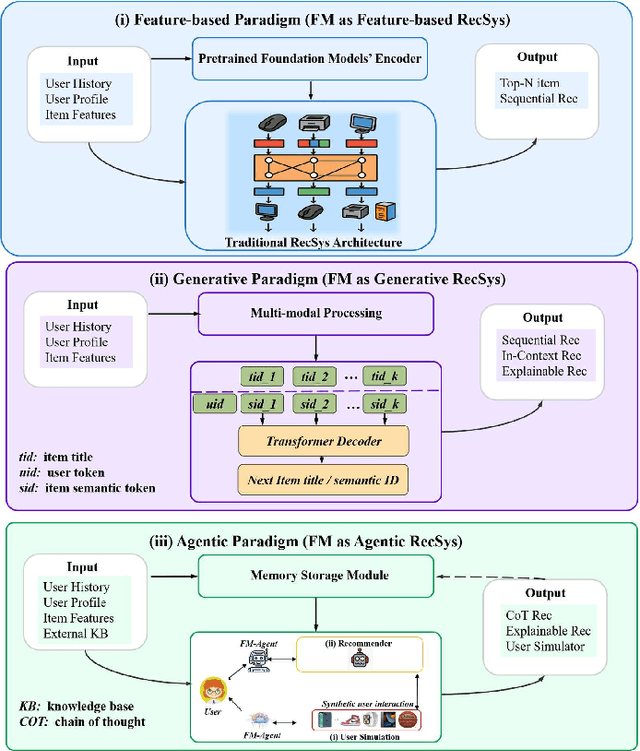
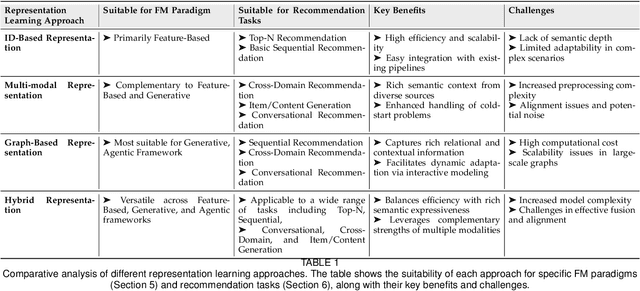
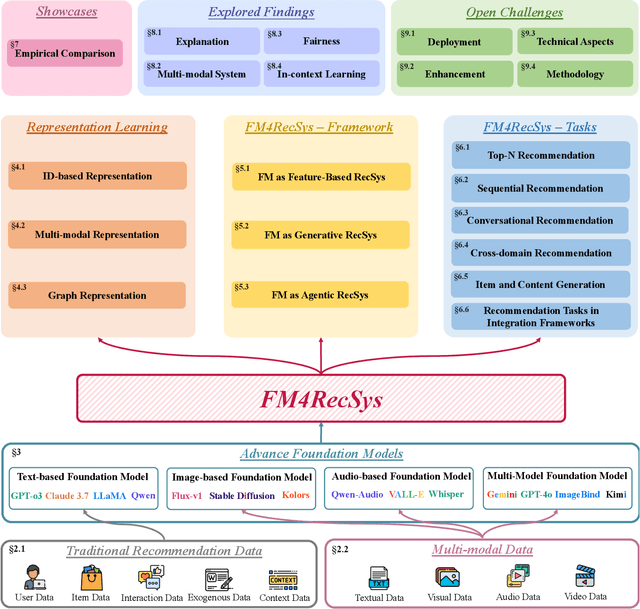
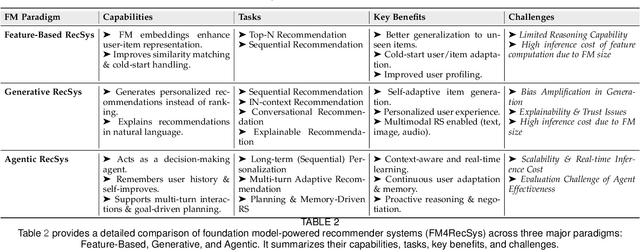
Abstract:Recommender systems (RS) have become essential in filtering information and personalizing content for users. RS techniques have traditionally relied on modeling interactions between users and items as well as the features of content using models specific to each task. The emergence of foundation models (FMs), large scale models trained on vast amounts of data such as GPT, LLaMA and CLIP, is reshaping the recommendation paradigm. This survey provides a comprehensive overview of the Foundation Models for Recommender Systems (FM4RecSys), covering their integration in three paradigms: (1) Feature-Based augmentation of representations, (2) Generative recommendation approaches, and (3) Agentic interactive systems. We first review the data foundations of RS, from traditional explicit or implicit feedback to multimodal content sources. We then introduce FMs and their capabilities for representation learning, natural language understanding, and multi-modal reasoning in RS contexts. The core of the survey discusses how FMs enhance RS under different paradigms. Afterward, we examine FM applications in various recommendation tasks. Through an analysis of recent research, we highlight key opportunities that have been realized as well as challenges encountered. Finally, we outline open research directions and technical challenges for next-generation FM4RecSys. This survey not only reviews the state-of-the-art methods but also provides a critical analysis of the trade-offs among the feature-based, the generative, and the agentic paradigms, outlining key open issues and future research directions.
From Reviews to Dialogues: Active Synthesis for Zero-Shot LLM-based Conversational Recommender System
Apr 21, 2025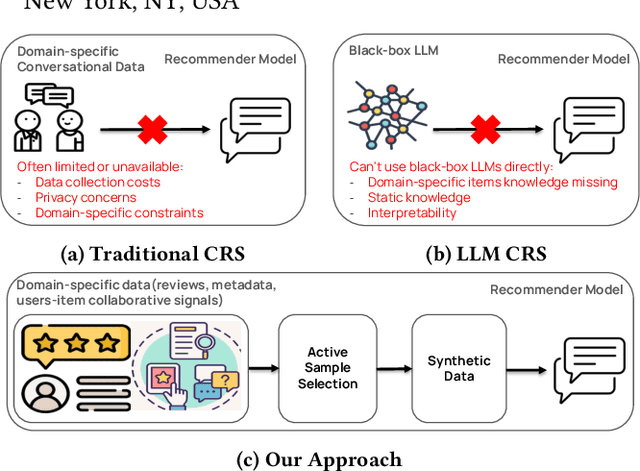
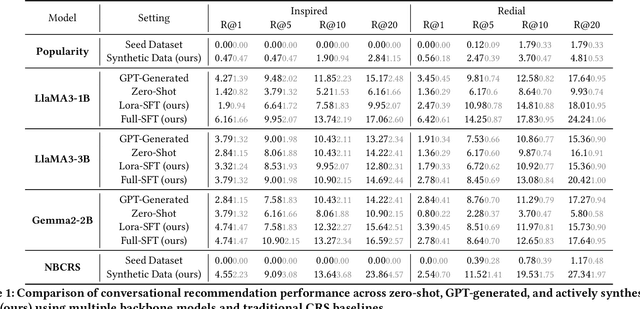

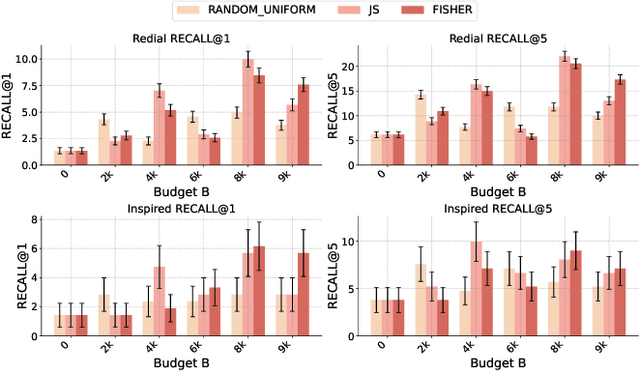
Abstract:Conversational recommender systems (CRS) typically require extensive domain-specific conversational datasets, yet high costs, privacy concerns, and data-collection challenges severely limit their availability. Although Large Language Models (LLMs) demonstrate strong zero-shot recommendation capabilities, practical applications often favor smaller, internally managed recommender models due to scalability, interpretability, and data privacy constraints, especially in sensitive or rapidly evolving domains. However, training these smaller models effectively still demands substantial domain-specific conversational data, which remains challenging to obtain. To address these limitations, we propose an active data augmentation framework that synthesizes conversational training data by leveraging black-box LLMs guided by active learning techniques. Specifically, our method utilizes publicly available non-conversational domain data, including item metadata, user reviews, and collaborative signals, as seed inputs. By employing active learning strategies to select the most informative seed samples, our approach efficiently guides LLMs to generate synthetic, semantically coherent conversational interactions tailored explicitly to the target domain. Extensive experiments validate that conversational data generated by our proposed framework significantly improves the performance of LLM-based CRS models, effectively addressing the challenges of building CRS in no- or low-resource scenarios.
In-context Ranking Preference Optimization
Apr 21, 2025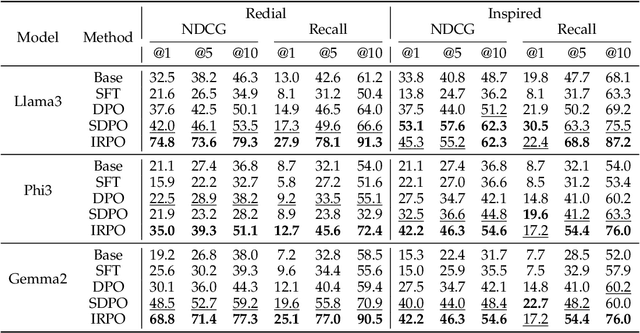
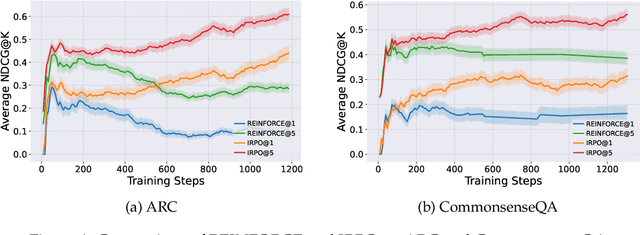
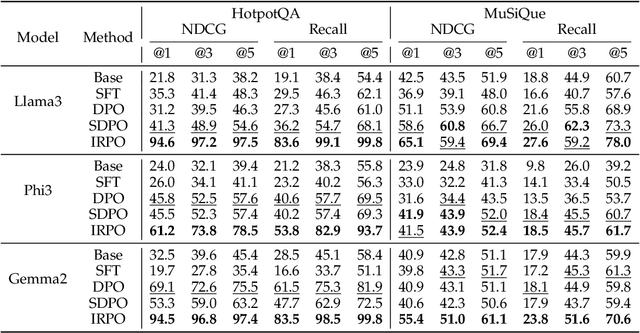
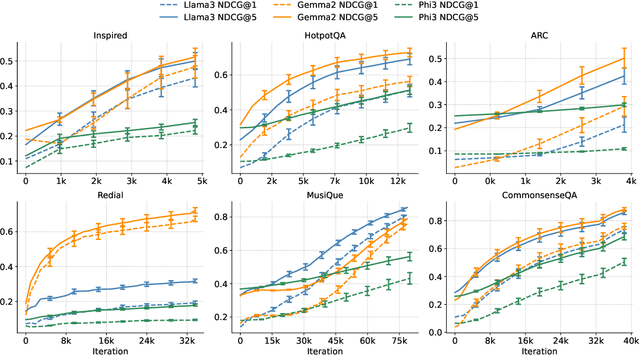
Abstract:Recent developments in Direct Preference Optimization (DPO) allow large language models (LLMs) to function as implicit ranking models by maximizing the margin between preferred and non-preferred responses. In practice, user feedback on such lists typically involves identifying a few relevant items in context rather than providing detailed pairwise comparisons for every possible item pair. Moreover, many complex information retrieval tasks, such as conversational agents and summarization systems, critically depend on ranking the highest-quality outputs at the top, emphasizing the need to support natural and flexible forms of user feedback. To address the challenge of limited and sparse pairwise feedback in the in-context setting, we propose an In-context Ranking Preference Optimization (IRPO) framework that directly optimizes LLMs based on ranking lists constructed during inference. To further capture flexible forms of feedback, IRPO extends the DPO objective by incorporating both the relevance of items and their positions in the list. Modeling these aspects jointly is non-trivial, as ranking metrics are inherently discrete and non-differentiable, making direct optimization difficult. To overcome this, IRPO introduces a differentiable objective based on positional aggregation of pairwise item preferences, enabling effective gradient-based optimization of discrete ranking metrics. We further provide theoretical insights showing that IRPO (i) automatically emphasizes items with greater disagreement between the model and the reference ranking, and (ii) links its gradient to an importance sampling estimator, yielding an unbiased estimator with reduced variance. Empirical results show IRPO outperforms standard DPO approaches in ranking performance, highlighting its effectiveness in aligning LLMs with direct in-context ranking preferences.
A Survey on Personalized and Pluralistic Preference Alignment in Large Language Models
Apr 09, 2025Abstract:Personalized preference alignment for large language models (LLMs), the process of tailoring LLMs to individual users' preferences, is an emerging research direction spanning the area of NLP and personalization. In this survey, we present an analysis of works on personalized alignment and modeling for LLMs. We introduce a taxonomy of preference alignment techniques, including training time, inference time, and additionally, user-modeling based methods. We provide analysis and discussion on the strengths and limitations of each group of techniques and then cover evaluation, benchmarks, as well as open problems in the field.
Towards Agentic Recommender Systems in the Era of Multimodal Large Language Models
Mar 20, 2025Abstract:Recent breakthroughs in Large Language Models (LLMs) have led to the emergence of agentic AI systems that extend beyond the capabilities of standalone models. By empowering LLMs to perceive external environments, integrate multimodal information, and interact with various tools, these agentic systems exhibit greater autonomy and adaptability across complex tasks. This evolution brings new opportunities to recommender systems (RS): LLM-based Agentic RS (LLM-ARS) can offer more interactive, context-aware, and proactive recommendations, potentially reshaping the user experience and broadening the application scope of RS. Despite promising early results, fundamental challenges remain, including how to effectively incorporate external knowledge, balance autonomy with controllability, and evaluate performance in dynamic, multimodal settings. In this perspective paper, we first present a systematic analysis of LLM-ARS: (1) clarifying core concepts and architectures; (2) highlighting how agentic capabilities -- such as planning, memory, and multimodal reasoning -- can enhance recommendation quality; and (3) outlining key research questions in areas such as safety, efficiency, and lifelong personalization. We also discuss open problems and future directions, arguing that LLM-ARS will drive the next wave of RS innovation. Ultimately, we foresee a paradigm shift toward intelligent, autonomous, and collaborative recommendation experiences that more closely align with users' evolving needs and complex decision-making processes.
Active Learning for Direct Preference Optimization
Mar 03, 2025Abstract:Direct preference optimization (DPO) is a form of reinforcement learning from human feedback (RLHF) where the policy is learned directly from preferential feedback. Although many models of human preferences exist, the critical task of selecting the most informative feedback for training them is under-explored. We propose an active learning framework for DPO, which can be applied to collect human feedback online or to choose the most informative subset of already collected feedback offline. We propose efficient algorithms for both settings. The key idea is to linearize the DPO objective at the last layer of the neural network representation of the optimized policy and then compute the D-optimal design to collect preferential feedback. We prove that the errors in our DPO logit estimates diminish with more feedback. We show the effectiveness of our algorithms empirically in the setting that matches our theory and also on large language models.
 Add to Chrome
Add to Chrome Add to Firefox
Add to Firefox Add to Edge
Add to Edge